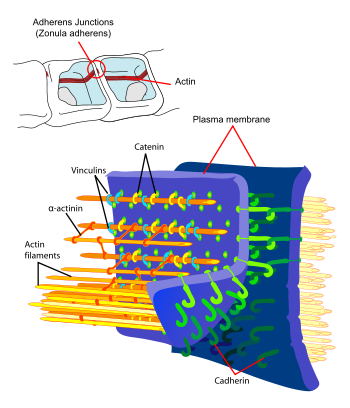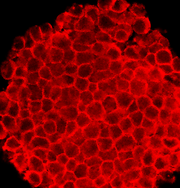
Catenin
Encyclopedia

Protein
Proteins are biochemical compounds consisting of one or more polypeptides typically folded into a globular or fibrous form, facilitating a biological function. A polypeptide is a single linear polymer chain of amino acids bonded together by peptide bonds between the carboxyl and amino groups of...
s found in complexes with cadherin
Cadherin
Cadherins are a class of type-1 transmembrane proteins. They play important roles in cell adhesion, ensuring that cells within tissues are bound together. They are dependent on calcium ions to function, hence their name.The cadherin superfamily includes cadherins, protocadherins, desmogleins, and...
cell adhesion
Cell adhesion
Cellular adhesion is the binding of a cell to a surface, extracellular matrix or another cell using cell adhesion molecules such as selectins, integrins, and cadherins. Correct cellular adhesion is essential in maintaining multicellular structure...
molecules of animal cells
Cell (biology)
The cell is the basic structural and functional unit of all known living organisms. It is the smallest unit of life that is classified as a living thing, and is often called the building block of life. The Alberts text discusses how the "cellular building blocks" move to shape developing embryos....
. The first two catenins that were identified became known as alpha-catenin and beta-catenin. Alpha-catenin can bind to beta-catenin and can also bind actin
Actin
Actin is a globular, roughly 42-kDa moonlighting protein found in all eukaryotic cells where it may be present at concentrations of over 100 μM. It is also one of the most highly-conserved proteins, differing by no more than 20% in species as diverse as algae and humans...
. Beta-catenin binds the cytoplasmic domain of some cadherins. Additional catenins such as gamma-catenin and delta-catenin have been identified. The name "catenin" was originally selected ('catena' means 'chain' in Latin
Latin
Latin is an Italic language originally spoken in Latium and Ancient Rome. It, along with most European languages, is a descendant of the ancient Proto-Indo-European language. Although it is considered a dead language, a number of scholars and members of the Christian clergy speak it fluently, and...
) because it was suspected that catenins might link cadherins to the cytoskeleton.
Types

- alpha-catenin
- beta-cateninBeta-cateninBeta-catenin is a protein that in humans is encoded by the CTNNB1 gene. In Drosophila, the homologous protein is called armadillo...
- delta-cateninDelta cateninDelta-1-catenin and Delta-2-catenin are members of a subfamily of proteins with ten Armadillo-repeats. Delta-2-catenin is expressed in the brain where it is important for normal cognitive development. Like beta-catenin and gamma-catenin, delta-catenins seem to interact with presenilins...
- gamma-catenin
All but alpha contain armadillo repeats
Armadillo repeats
Armadillo repeats are named after the β-catenin-like Armadillo protein of the fruit fly Drosophila. These repeats are about 40 amino acids long and proteins that contain them have many tandemly repeated copies. Each Armadillo repeat is composed of a pair of alpha helices that form a hairpin...
.
Catenins and cadherin function
F9 embryonal carcinoma cells are similar to the P19 cells shown in Figure 1 and normally have cell-to-cell adhesion mediated by E-cadherin with beta-catenin bound to the cytoplasmic domain of E-cadherin. F9 cells were genetically engineered to lack beta-catenin, resulting in increased association of plakoglobin with E-cadherin. In F9 cells lacking both beta-catenin and plakoglobin, very little E-cadherin and alpha-catenin accumulated at the cell surface. Mice lacking beta-catenin have defective embryos. Mice engineered to specifically have vascular endotheliumEndothelium
The endothelium is the thin layer of cells that lines the interior surface of blood vessels, forming an interface between circulating blood in the lumen and the rest of the vessel wall. These cells are called endothelial cells. Endothelial cells line the entire circulatory system, from the heart...
cells deficient in beta-catenin showed disrupted adhesion between vascular endothelial cells. Mice lacking plakoglobin have cell adhesion defects in many tissues, although beta-catenin substitutes for plakoglobin at many cellular junctions. Keratinocytes engineered to not express alpha-catenin have disrupted cell adhesion and activated NF-κB. A tumor cell line with defective delta-catenin, low levels of E-cadherin and poor cell-to-cell adhesion could be reverted to normal epithelial morphology and increased E-cadherin levels by expression of normal levels of functional delta-catenin.

